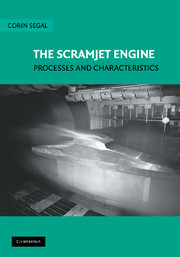Book contents
- Frontmatter
- Contents
- Preface
- List of Acronyms
- 1 Introduction
- 2 Theoretical Background
- 3 High-Temperature Gas Dynamics and Hypersonic Effects
- 4 Cycle Analyses and Energy Management
- 5 Inlets and Nozzles
- 6 Supersonic Combustion Processes
- 7 Testing Methods and Wind Tunnels
- 8 Computational Fluid Dynamic Methods and Solutions for High-Speed Reacting Flows
- Index
- References
3 - High-Temperature Gas Dynamics and Hypersonic Effects
Published online by Cambridge University Press: 19 January 2010
- Frontmatter
- Contents
- Preface
- List of Acronyms
- 1 Introduction
- 2 Theoretical Background
- 3 High-Temperature Gas Dynamics and Hypersonic Effects
- 4 Cycle Analyses and Energy Management
- 5 Inlets and Nozzles
- 6 Supersonic Combustion Processes
- 7 Testing Methods and Wind Tunnels
- 8 Computational Fluid Dynamic Methods and Solutions for High-Speed Reacting Flows
- Index
- References
Summary
Introduction
As the air energy increases, molecular vibrational excitation, followed by dissociation and chemical reactions, accompanies flows at high speed; it occurs on both the external vehicle surface and in the scramjet flow path. The viscous layer generated on the vehicle forebody, following deceleration and interactions with shock waves, may exhibit temperatures in excess of thousands of degrees. At these temperatures, chemical effects are just as important as in combustion chambers, where chemical reactions are intentionally induced and controlled; the gas composition departs substantially from the simplifications made through the assumption of thermal or calorically perfect gas and has a substantial impact on the flow structure, energy distribution, and, finally, thrust generation. The gas properties must therefore be determined from a microscale perspective that takes into account the molecular motion, the distribution, and transfer of energy between the molecules present in the flow.
This chapter reviews the molecular motion and the determination of real-gas and transport properties from the description of the flow molecular structure. Further, specific issues that distinguish the high-speed flows in the regime that is generically referred to as “hypersonic” are reviewed. Without any abrupt demarcations in the flow properties, the hypersonic regime is considered in general to exist when the flight Mach number exceeds a value of ∼ 5 For a more accurate definition, the hypersonic regime could be considered to manifest when the entropy layer close to a surface immersed in the fluid becomes significant (Anderson, 1989).
Information
- Type
- Chapter
- Information
- The Scramjet EngineProcesses and Characteristics, pp. 35 - 61Publisher: Cambridge University PressPrint publication year: 2009
